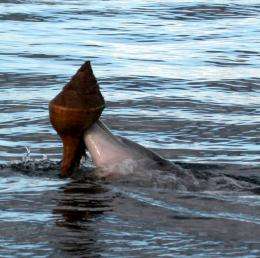Ingenious fishing method may be spreading through dolphins

(PhysOrg.com) -- Researchers from Murdoch University believe a recently documented method of fishing may be spreading throughout a population of dolphins.
Indo-Pacific bottlenose dolphins (Tursiops aduncus) in Shark Bay were photographed engaging in ‘conching’ in 2007 and 2009.
The dolphins would trap small fish in large conch shells with their rostrums (beaks), then bring the shells to the surface and shake them, causing the water to drain out and the fish to fall into their mouths.
Murdoch Cetacean Research Unit Researcher Simon Allen says this previously rarely witnessed phenomenon might be on the increase, suggesting that the technique is spreading.
“In the last four months alone, the research team have seen and photographed the behaviour no less than six times, possibly even seven.
“If – and that is a big if – we are witnessing the horizontal spread of this behaviour, then I would assume that it spreads by an associate of a ‘conching’ dolphin closely observing the behaviour and then imitating it,” Mr. Allen said.
“It is a tantalising possibility that this behavior could spread before our very eyes – over a field season or two – and that we could track that spread.”
The prospect of observing a learned behavior spreading through a population over a short period of time is exciting in itself, but the behavior also raises new questions about how exactly dolphins engage in conching.
“As yet, we don’t know if dolphins simply pursue fish into the ‘refuge’ of the large, empty conch/bailer shells or whether they actually manipulate the shells prior – perhaps turning them over so that the opening is facing up in order to make them ‘appealing’ to fish as a place to hide from the jaws of death,” Mr. Allen said.
“If we were to set up a few shells – opening down – in a known location and either witness dolphins turning them over, see evidence of them having been turned over when we weren’t around, or better still get some video footage of dolphins manipulating them in some way, then that would be priceless, since that implies forward planning on the dolphins’ part.
“I wouldn’t be too surprised to find such cunning and devilish ploys being adopted by Shark Bay’s bottlenose dolphins.”
Until such observations are recorded though, Mr. Allen says it is too early to rush to any conclusions.
Members of the Murdoch Cetacean Unit, with colleagues from the University of Zurich, spend roughly four months of the year studying western Shark Bay’s dolphin population in the field.
The Unit operates with the assistance of a partnership with Shark Bay Resources, who provide accommodation, office space and mess facilities for the research teams.
Provided by Murdoch University

















